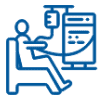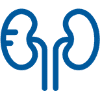For people living with kidney disease and on dialysis, watching your potassium intake can feel like a daily chore. Luckily potassium is now required on the Nutrition Facts Panel (food label) found on packaged foods, making it easier to manage your daily potassium. Each person’s daily potassium goal is unique (talk with your dietitian about your specific daily goal), but a good standard daily goal for someone with Stage 5 KD on dialysis is under 2,100mg per day or <700mg per meal, less if you are going to have a snack.
What to know about potassium:
(1) 251mg or more of potassium in a serving is considered a high potassium food.
(2) 150 or less of potassium per serving is considered a low potassium food
(3) Low potassium foods can become high potassium foods if eaten in larger portions
(4) Limit or avoid foods with added potassium especially if it has more than 3 sources of added potassium, these sources of potassium are more absorbable than naturally occurring potassium (a) You can find added potassium on the ingredients list below the food label












